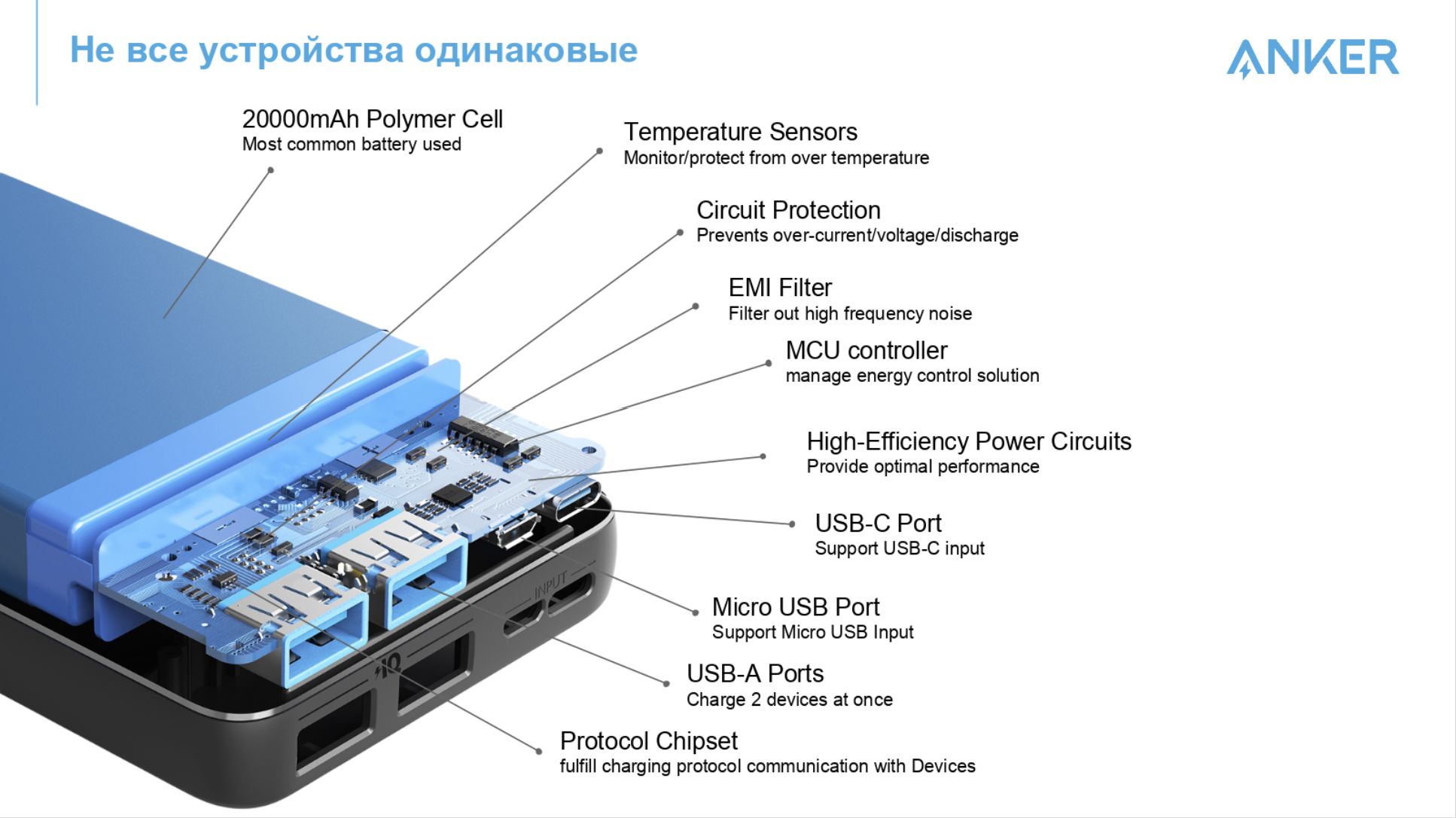
Photo: Anker
What does a powerbank consist of?
In general, such a charging device is quite primitive. Regardless of the shape and size, one or several battery cans, a controller that provides charge / discharge, a pulse transformer and a bunch of connectors for connecting a load (smartphone, camera or laptop) are hidden inside. The devil, as usual, is in the details.
Batteries are about the same for everyone - either soft unpackaged lithium batteries or standard 18650 cells. This has almost no effect on the operation of the device itself - the ratio of capacity to size is about the same everywhere, and you should not expect miracles here. If breakthrough technologies were available to someone and - believe me, they would be shoved into mobile phones the next day, and not into power banks. The question of the quality of the "cans" themselves inside the portable charging remains on the conscience of the manufacturer, so the Chinese brand may not give out the promised currents or volumes for obvious reasons.

The classic scheme of a Chinese powerbank: a battery of the minimum capacity, the cheapest board, two sandbags for weight. Photo: Says.com
The main difference between "good" and "not so good" power banks is the electronics unit, which provides both charging of the internal batteries themselves and the operation of the device with various equipment, which you will feed them. It can be both as primitive as possible (that is, it will only convert the voltage and monitor the state of the built-in battery), or a technically complex device that regulates dozens of parameters. A good portable charger not only provides the transformation of 3.7 volts into 5 or 12 volts, but also monitors the temperature inside the case, controls the uniform wear of the cells and their individual parameters, and most importantly, solves the problem with fast charging protocols.

Well, now with the arrival of USB Type-C, the mess will definitely end. Or not ... Photo: xkcd.ru
A million options for "fast charging" is no different from a bunch of different connectors in mobile phones of the decade before last. This is due to the market economy and the reluctance of some companies to pay patent royalties. It is more profitable to come up with something of your own and also make money on unique accessories than to adapt to someone, spend money on changing production chains, breaking compatibility with existing products ... In general, there are a lot of reasons, but the result is the same - not all devices are charged the same quickly if a non-factory power supply is used. At least that was the case before.
What are the fast charging protocols?
In order for a gadget for almost a thousand dollars that has sat down for lunch not to upset its owner much, engineers have taught smartphones and laptops fast charging. Some ten years ago, putting a cell phone on charge at night was the norm - batteries for one and a half or two thousand milliampere-hours slowly gained percentages from standard units at 5 volts 0.5 amperes. Today, charging from 0 to 100 percent in more than 2 hours is considered bad manners - and, willy-nilly, power banks have to comply.
The problem is that there are a lot of protocols for this fastest charging: it all started with Qualcomm Quick Charge - the chips of this giant are installed in most mobile phones, but Samsung has its own processors - and its own fast charging protocol, partially compatible with QC 2.0. And then there is Huawei with Kirin (and its proprietary developments), MTK devices with Pump Express, and a whole collection of gadgets from the BBK conglomerate that require a special chip cable for fast charging and use a non-standard Super VOOC protocol.
There is even a special genre of video - a race of fast charging protocols.
The cherry on top is actually the USB Power Delivery standard adopted by Apple as the basis for fast charging. In short - previously, only one basic power profile was allowed via USB - 5 Volts and 0.5 (USB 2.0) or 0.9 (USB 3.0) Ampere. Then we developed an extension to the USB Power Delivery standard, which took into account the requirements of modern power gadgets and made it possible to change these profiles.
USB Power Delivery changes two key parameters. Firstly, gadgets can agree among themselves who will be the source and who will be the consumer (this is how reverse charging appeared - you can charge headphones or another phone with your phone). Secondly, when both devices support this protocol, they can go beyond 5 Volts and 0.9 Amps. Consumers can request high currents and voltages from the source - up to 20 Volts at 5 Amperes (100 W) - and the source, depending on its capabilities, provide such power.
And how, one wonders, with all this zoo to make a human portable battery?
How to create a truly versatile gadget?
Standard batteries give out from 3.7 to 4.3 volts - and gadgets are charged with a voltage of 5 to 12 volts, depending on the charging protocol and the current stage (some "smart" chargers change the voltage and current depending on the battery charge level of the consumer). With the conversion of one voltage to another, no questions arise - but how to ensure fast charging with such a zoo of standards?
Aided by the dedicated PowerIQ 3.0 protocol chipset developed by Anker for portable chargers. When the battery is connected to your native storage device, it recognizes and copies the "fast charging" communication protocol into the internal memory. And when you connect your smartphone or laptop to the powerbank, PowerIQ selects the correct fast charging standard upon request from the gadget and provides the same performance as charging from a 220 volt network.

Anker PowerCore. Photo: Anker
Anker knows how to make high-quality chargers, having such experience behind it, making a good powerbank is not difficult. We take reliable batteries from trusted suppliers - for 20 or 10 thousand mAh, we equip them with additional temperature sensors. So you can be sure that the "banks" during charging or operation do not overheat (and therefore degrade less) and reduce the load to extend the life of the device. We equip power circuits with protection against high currents and voltages, as well as a hardware switch to reduce self-discharge currents. And then the fun begins.

Photo: Anker
In addition, the chipset monitors the condition of your cable and conductor resistance losses, making appropriate adjustments to the charging algorithm - thus ensuring the fastest possible replenishment of your device's battery. Not to mention such commonplace things as protection against short circuits, overheating, high currents, etc. - most conventional power banks provide only basic control of parameters during their own charging - and then only in order to protect the built-in batteries from spontaneous combustion.
Outcome
What makes a good powerbank different from a regular one? For the average user, almost nothing. In an emergency, both will save, but with regular use, everything changes. With Anker's power bank, you don't have to walk around with a “brick” of a battery and a bundle of wires in your pocket, risking them catching on any protruding object and thereby sending your brand new iPhone flying.
The charging speed, which is not inferior to the complete 220 Volt SZU, allows you to replenish up to 50% of the battery charge of your smartphone in 20–30 minutes and use it further without wires. And full support for USB Power Delivery makes it possible to charge not only a phone or tablet, but also a laptop. The main thing is to have the appropriate double-sided Type-C at hand.